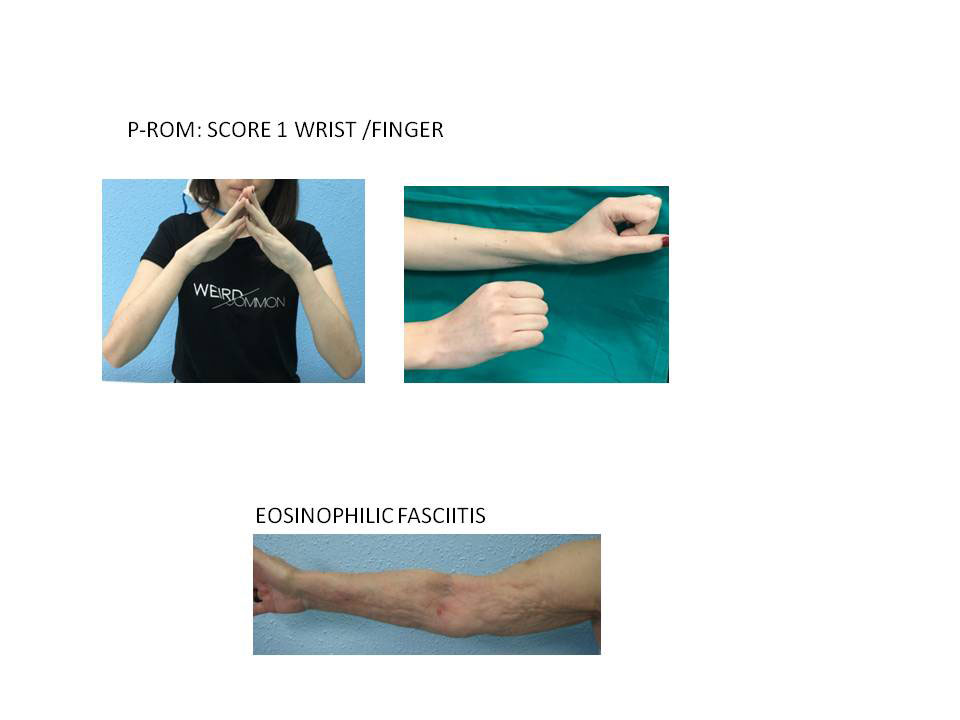Session Information
Session Type: Poster Session (Monday)
Session Time: 9:00AM-11:00AM
Background/Purpose: Introduction: Chronic graft-versus-host disease (cGVHD) is a major cause of morbidity and mortality after allogeneic hematopoietic stem cell transplantation (HCT). Clinically, cGVHD is a multiorgan syndrome involving tissue inflammation and fibrosis that often result in permanent organ dysfunction with important repercussions at the systemic, cutaneous and musculoskeletal levels.
Objectives: To describe the musculoskeletal and connective tissue manifestations, in the first visit, of the patients with cGVHD treated in a multidisciplinary consultation (Hematology /Dermatology/Rheumatology).
Methods: Material and methods: Observational and prospective study to describe the clinical characteristics of patients with cutaneous and musculoskeletal cGVHD collected in the database. We describe the clinical characteristics of 58 patients with sclerodermiform GVHD well cutaneous, fascial and / or tendinous detected in the first visit. The usual variables, the transplant reason disease, the type of transplant, and the assessment of clinical manifestations according to NIH diagnostic and follow-up criteria: for skin involvement, ROM (range of motion) and P-ROM (scale of photographic range of motion) to objectify the degree of limitation of joint mobility. The descriptive and frequency statistical analysis is done through Microsoft Office Excel 2007.
Results: Results: Sixty-three (67%) of the patients seen in the clinic had some type of non-lichenoid and / or musculoskeletal skin reaction. Five (7%) patients did not meet diagnostic or distinctive criteria of cGVHD (1 muscle cramps, 2 arthralgias and 2 polymyalgia). The cohort with sclerotic involvement (58 patients): 23 (40%) were women and 35 (60%) males, with a mean age of 52 years (r 7-78 years). The most frequent diseases that cause the transplant were acute myeloid leukemia (32%) and non-Hodgkin lymphoma (31%), and thirteen (22%) patients did not receive immunosuppressive treatment at the time of the visit. Ten (30%) patients were diagnosed by skin biopsy. The mean time from transplant to the initial visit was 3 years (r 8 months to 9 years). Seven (12%) had musculoskeletal sclerotic involvement (fascial / tendinous) detected by ROM without objective cutaneous involvement and the cutaneous involvement was severe in most cases (Tables attached)
Table 1: Skin and joint/fascia scoring
|
SCORE 0 |
SCORE 1 |
SCORE 2 |
SCORE 3 |
|
|
ECOG* |
43 (74%) |
12 (20%) |
2 (3%) |
1 (1,7%) |
|
ROM^ |
43 (74%) |
11(19%) |
3(5%) |
1(1,7%) |
|
Skin” |
7(12%) |
0(0%) |
11(19%) |
40 (69%) |
*ECOG Eastern Cooperative Oncology Group Perfomance status “ ROM Range
of mobility
Table 2: Clinical forms
|
|
n= 58 |
|
Sclerodermiform Superficial Scl Deep Scl Lipodermatosclerosis type Mixed (lichenoid + Scl) Soft tissue sclerosis without skin involvement
|
41 (70%) 11 (19%) 21(36%) 3 (5%) 6 (10%) 10 (17%) 7 (12%) |
Conclusion: Conclusions: Sclerodermiform affectation is very common in our cohort, with fascial and tendon affectation, mainly of the flexor tendons of the carpus, the most frequent and, sometimes, without cutaneous involvement, making it difficult to detect them, being necessary the use of scales of joint assessment systematically. Physiotherapy is a fundamental part of the treatment.
To cite this abstract in AMA style:
Hidalgo C, López Corral L, Roman C, Gómez-Lechón L, Acosta M, Compan O, Pérez E, Montilla C, Caballero M. Cutaneous and Musculoskeletal Clinical Characterization of a Cohort of Patients with Chronic Graft-versus-host Disease [abstract]. Arthritis Rheumatol. 2019; 71 (suppl 10). https://acrabstracts.org/abstract/cutaneous-and-musculoskeletal-clinical-characterization-of-a-cohort-of-patients-with-chronic-graft-versus-host-disease/. Accessed .« Back to 2019 ACR/ARP Annual Meeting
ACR Meeting Abstracts - https://acrabstracts.org/abstract/cutaneous-and-musculoskeletal-clinical-characterization-of-a-cohort-of-patients-with-chronic-graft-versus-host-disease/

